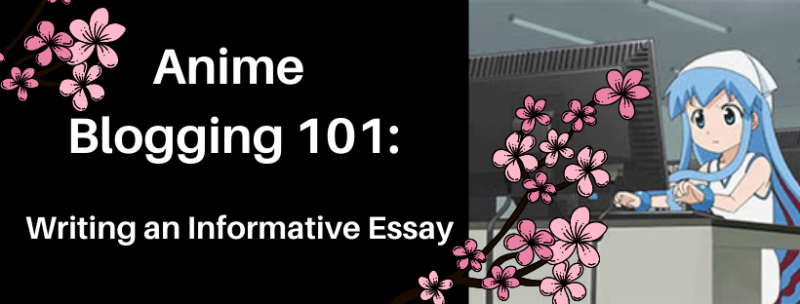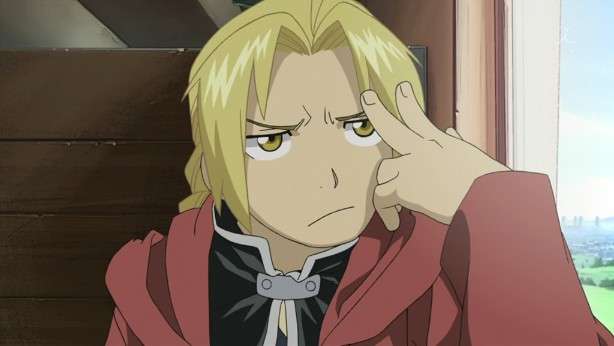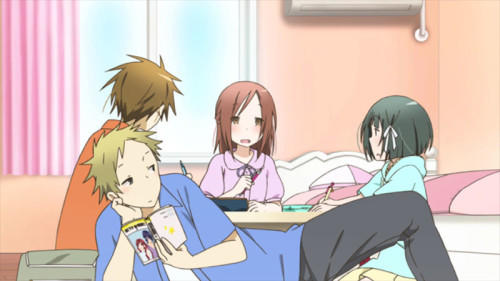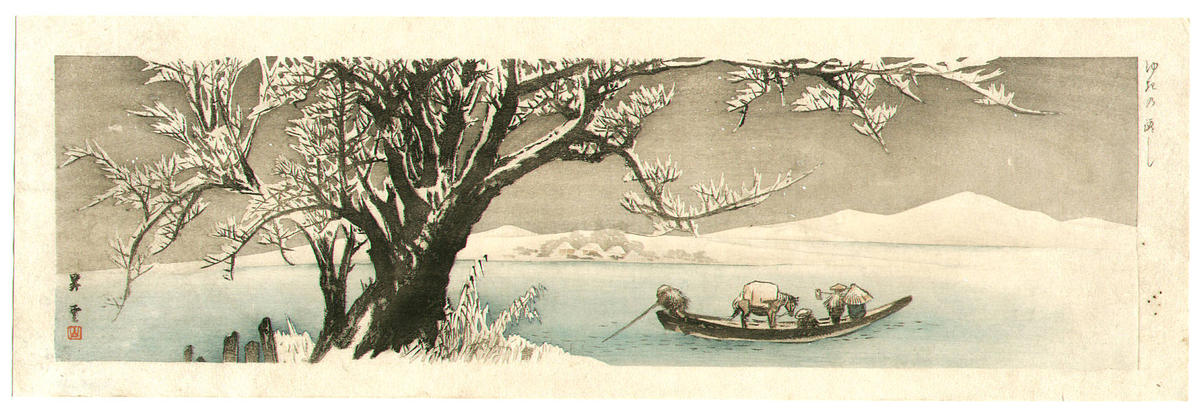
I love writing informative essays. I never know what goodies I will find when I set out to research for an informative essay. Informative essays involve all the gobbledygook about citations, quality of information, and copyright we’ve discussed. They also use the same writing techniques as reviews and critiques. The phrase informative essay sounds boring, but these articles should never bore the reader. The goal of these posts is to educate (hey, it’s not a bad word!) the reader while still entertaining them. Let me give you a few example essay titles from JP:
Informative essays present facts and your understanding of these facts. Anime fans can’t learn enough about Japan or anime. These essays let you delve into gender issues, biographies, folklore, art, poetry, literature, language, history, and…well, you get the idea. Because anime is a cultural product, you can relate it back to each of these topics if you want. Or you can just write to educate.
Don’t write informative essays like you would a classroom assignment. You don’t have to be stuffy, but you have to be accurate. Be certain you understand what you are writing about.
A good essay will remain relevant longer than a standard anime review. Anime become popular and then disappears. Some have lasting significance, like Neon Genesis Evangelion, but most will fade. Your posts will also fade with them. Although, it is possible for a review to rekindle interest in an old title. However, a well-written informative essay will have staying power, especially if it is focused on history or culture. It takes a long time for culture to change, and history remains constant outside of new discoveries or perspectives. These essays can generate more views over longer periods than popular, but short-lived anime reviews. This idea is called long-tail. Long-tail articles last and collectively outdo the most popular articles. They are the articles that keep people coming.
Informative essays can be frustrating in this regard. They take a lot of effort to research and write. You also don’t see your effort pay off immediately. Sometimes it can take years before the article gets traction. One of my most popular articles, A Look at Gender Expectations in Japanese Society, took over two years to gain traction. However, it eventually became one of my most popular posts. Blogging requires patience and persistence.
Writing an Engaging Informative Essay

An informative essay needs to be easy to read and, above all, useful. Readers need to find the information useful for their own projects, assignments, or interests. Otherwise, they won’t care. But how do you know what is useful? Watch the anime blogging community. Look at what other bloggers are discussing and the questions they are asking. Consider questions people outside the anime community may have. Think about what you didn’t understand about anime at first. What aspects of anime still confuse you? Chances are, others will share your questions. The amount of topics you can choose from makes it tough. Start with a question you find interesting and work from there. Most of the time, you will see other topics and questions as you write. Jot them down for later.
Informative essays use the same techniques as reviews for hooking readers. Questions, interesting facts, and quotes are especially useful for these essays. Just be careful not to use the same techniques too often. Tuck in personal stories time to time. Essays lend themselves toward stodgy, boring writing. Sometimes you don’t have much choice in the matter if you are dealing with a sensitive topic like hentai or World War II’s comfort women. Jokes in an article about what these women experienced wouldn’t be appropriate. Breezy writing also wouldn’t work. When writing about sensitive topics in history, an objective voice helps you deal with the information respectfully. To decide what tone works best, think about how you would feel if you were a survivor, were a former comfort woman, or had experienced the event. What tone of voice would insult you? Avoid that tone.
Whenever I write about a controversial topic, I drop into an academic tone for that post or paragraph. But what do I mean by this? Compare these paragraphs:
People often ask me for help with choosing topics for essays and thesis assignments. Anime gives us many, many topics to write about. Sometimes too many. So here is a list of ideas and links to articles I’ve written that have sources you may find useful.
Hentai is as valid a branch of manga and anime as shonen and shojo. Hentai has a long history and conflicted definitions. The word is a compound word that describes a person, action, or state of being sexually abnormal. Hentai describes a sub-genre of erotic literature rather than all erotic literature.
The first paragraph has a breezy, conversational style. I use fragments to make it sound like I’m speaking directly to you. The second paragraph takes on a more academic tone. You don’t find many I’s, me’s, or you’s in objective writing. Notice the difference in passive and active verbs. Objective writing relies more on passive voice because it states how something exists. Be careful not to overdo this, however. It makes people yawn and click away.
Trust your information to hold reader’s attention. If they are interested in the topic, they will read (or the skimming that passes as online reading) it. It doesn’t hurt to use good images to give the reader places to rest. The dryer you write, the more exciting your images will need to be. The contrast between a goofy or exciting image and objective text will keep readers interested.
Use quotations and paragraphs to advantage. You don’t want walls of text. Chunk long passages into several smaller paragraphs. This lets the eye rest and helps the reader feel like they are making faster progress. Quotations can act like images. They let the eye rest and provide interest.
Have a unique perspective. No one wants you to read and regurgitate. Bring a personal twist to the information. Look for connections people may not have noticed before. Look at a topic from the opposite side. For example, look at how some Japanese soldiers felt about being forced to use comfort women during World War II. This different perspective will keep readers interested.
Anatomy of an Informative Essay

You have noticed by now that there really isn’t a wrong way to write. It all depends on your topic and your reader. Informative essays can be approached in several ways. However, each method requires you to have a central premise or argument. The rest of the essay supports the premise. If you want to write about how to interpret the symbols found in Japanese woodblock prints, you need to introduce what woodblock prints are, discuss their history, and discuss how feudal Japan understood the symbols. Informative essays can’t assume knowledge, but it’s also easy to get lost in background detail. Let’s use woodblock prints to show one way to structure an informative essay.
Paragraph 1– the hook. Just like reviews and critiques, we have to make the reader want to read. It also needs to give readers a clue about what they will be reading. Look at this example:
Ukiyo-e, manga’s great-great-great-great-great grandmother, gives us a window on the Edo period of Japan. Four-hundred years in the future, our grandchildren may look upon today’s manga as we do ukiyo-e. That’s something to think about!
Section 1 – provide only the background information the reader needs to understand what you are discussing. Again, be careful not to get lost in this background information. A few sentences to a few paragraphs are all you need.
Ukiyo-e, or woodblock prints, are images made by pressing carved, inked wooden blocks to paper.
Section 2 – the body. It’s best to divide this section into various subsections, each dealing with a different topic. Label each subsection with headings. Section 2 is where you do most of your work. Here are a few headings for our woodblock print essay to give you an idea:
- Ukiyo-e, Merchants, and the Red Light District
- Censoring Ukiyo-e
- Erotic Ukiyo-e
- The Making of a Woodblock Print
- How to Read Ukiyo-e
Use your HTML header tags to organize your headings. The title of your article should be Header 1. Subsections should be Header 2. Additional divisions in your subsections should be Header 3 and so on. This helps readers and search engines understand how your thoughts are organized.
Conclusion – Don’t tell ‘em what you just told ‘em. Provide a last interesting bit of information or end with your thoughts. Tie everything together. You want readers to think about your essay. People remember beginnings and endings (especially endings). So end strong.
Ukiyo-e and manga share similar art styles: flat coloration with prominent outlines. Ukiyo-e was the popular media of the time, entertaining people and telling stories. The cheap cost of ukiyo-e allowed it to spread throughout the Edo period. Manga does the same today. It is relatively inexpensive and is a part of Japanese popular culture. Ukiyo-e experimented with ways of representing motion and emotion with minimal lines. The prints laid the framework for all the genres and themes we see in manga: erotica, macabre, humor, historical stories, current events, and slice of life. Manga inherited the free thinking and experimentation of the floating world. Ukiyo-e is a look at the lost floating world of dreams and suffering. The dreams of pleasure, conversation, and culture came at the price of the women and men sold into its work. Ukiyo-e freezes moments, people, and concerns in ink.
Organizing Section 2
There are a couple of ways to organize your essay’s body.
Chronological
This works best for historical essays. If you are writing about how mecha anime developed, it’s best to start with Astro Boy and work through Robotech and modern mecha. Reverse chronological order also works fine.
Interlaced Topics
This method involves weaving a pattern to your argument. Compare and contrast, for example. Pros and cons is another example. The rhythm helps readers digest the information better. It also makes it easier to write. You can use these methods in a single paragraph or split them into separate paragraphs. Think about how we structure a critique with positive and critical paragraphs. That is the interlaced topic method.
Anecdote
This works best when you have a personal story related to the information you write about. Share an experience to make the idea concrete. We think in terms of real things instead of abstract ideas. Explain an idea in this way. Share a personal story. Images, audio, and video also act as anecdotes.
Q&A
Questions and answers are most often used with interviews. However, you can use the format to help you structure information. I like to use this method with the Chronological method. After going over the history of the topic, I like to ask questions about why a piece of information matters or why an event happened.
You can mix and match these in many different ways. You can also use the review structure. The freedom of blogging makes it difficult. There are too many methods, topics, and grammar to juggle sometimes. There are too many anime to watch and review. Not to mention Japanese history, folklore, music, literature, manga, and food. So how can you avoid being overwhelmed? How can you stay motivated?
References
Hale, C., Sin and Syntax: How to Craft Wicked Good Pros,. New York: Three Rivers Press, 2013.
Strunk, W., and E.B. White. The Elements of Style. Longman 4th Edition. 1999.
University of Chicago Press. The Chicago Manual of Style, 16th ed, Chicago: University of Chicago Press, 2010.



